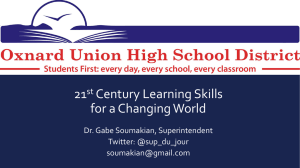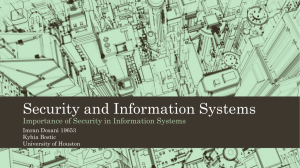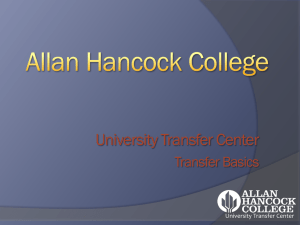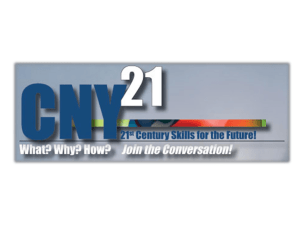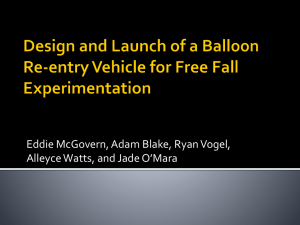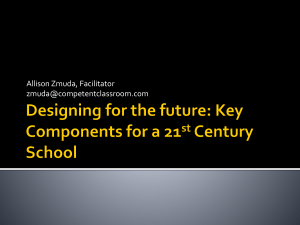fernandes
advertisement
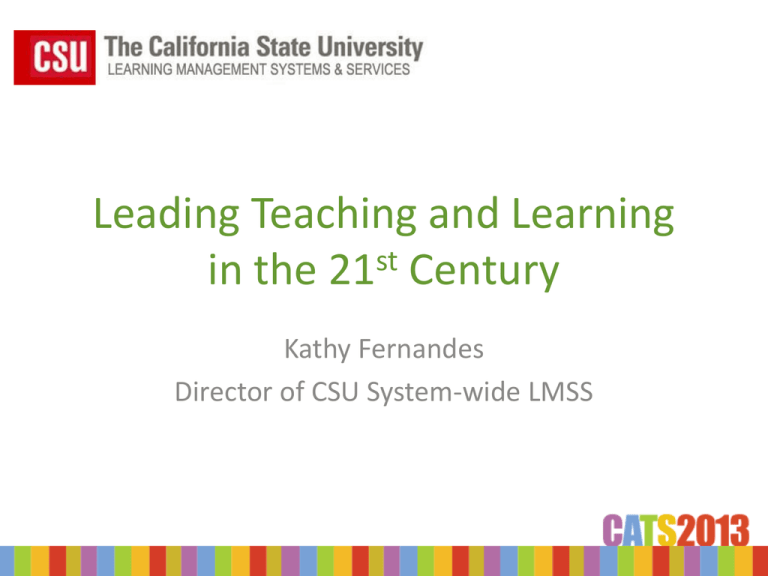
Leading Teaching and Learning in the 21st Century Kathy Fernandes Director of CSU System-wide LMSS “If we are learning in new ways, why are they still teaching us in old ways?” Sydni Powell, CSUN A.S. VP CSSA Technology Officer Photo courtesy of Amanda Flavin and Sydni Powell "If we teach today's students as we did yesterday's, we are robbing them of tomorrow." John Dewey, 1859 – 1952 “Don’t limit a child to your own learning, for he was born in another time.” Rabindranath Tagore, 1861 – 1941 “Tell me and I'll forget; Show me and I may remember; Involve me and I'll understand.” – Chinese Proverbs quotes Tell me and I'll forget Lecture Show me and I may remember Chalk board, books, audio/visual ENGAGE me and I'll understand Internet, games, smartphones, social media, virtual worlds So What About Teaching and Learning in the 21st Century? • Pedagogy is the science and art of education. Its aims range from the full development of the human being to skills acquisition. - Wikipedia Andragogy - developed into a theory of adult education by the American educator Malcolm Knowles whose theory stated six assumptions related to motivation of adult learning: 1. Adults need to know the reason for learning something (Need to Know) 2. Experience, including error, provides a basis for learning activities (Foundation) 3. Adults need to be responsible for their decisions on education; involvement in the planning and evaluation of their instruction (Self-concept). 4. Adults are most interested in learning subjects having immediate relevance to their work and/or personal lives (Readiness) 5. Adult learning is problem-centered rather than content-oriented (Orientation) 6. Adults respond better to internal versus external motivators (Motivation) Instructional Design is the practice of creating "instructional experiences which make the acquisition of knowledge and skill more efficient, effective and appealing.” • The process consists broadly of determining the current state and needs of the learner, defining the end goal of instruction, and creating some "intervention" to assist in the transition. • Ideally the process is informed by pedagogically (process of teaching) and andragogically (adult learning) tested theories of learning. • There are many instructional design models but many are based on the ADDIE model with the five phases: 1) analysis, 2) design, 3) development, 4) implementation, and 5) evaluation. - Wikipedia Historical Overview: Learning Theories Socrates: Piaget: Vygotsky: Socratic Method Equilibrium/Disequilibrium Zone of Proximal Learning [469-399 B.C] [1896-1980] [1896-1934] Maria Montessori [1870- 1952] Actual Proximal Booker T Washington [1856-1915] Dewey: Virginia Randolph Vocational Learning Papert: Problem-Based Learning [1870-158] Bruner: Constructionism Active Learning [1928-] [1859-1952] Paolo Freire [1915-] Generative Themes [1921-1997] IDIT HAREL CAPERTON RICKI GOLDMAN Slide creation thanks to Ruth Cox @ SFSU Sum of the Parts > Whole ?? • Change! Rapid Technological Change! • No Change! Pedagogical approaches to teaching and learning • Pedagogy + Technology = Some Change? • MOOCs = Disruption of Education Dialogic Literacy “the ability to engage productively in discourse whose purpose is to generate new knowledge and understanding.” Dialogic literacy is a fundamental literacy for a knowledge society. Developing 21st Century Teaching and Learning: Dialogic Literacy • Old pedagogy + old technology = low performance improvement. • Old pedagogy + new technology = mild performance improvement. • New pedagogy + old technology = mild performance improvement. • New pedagogy + new technology = high performance improvement. education.jhu.edu/PD/newhorizons/strategies/topics/literacy/articles/ developing-21st-century-teaching/index.html Developing 21st Century Teaching and Learning: Dialogic Literacy By Nicholas Abbey@Johns Hopkins • “…the alignment between new pedagogies and new technologies is the single most important factor for optimal performance in any organization as well as the key challenge for those seeking to develop 21st century teaching and learning.” CSU Quality Online Learning and Teaching qolt.ecatalst.org Who at your institution knows about… – Pedagogy and Andragogy – Learning Theories – Instructional Design 1) 2) 3) 4) 5) Analysis Design Development Implementation Evaluation/assessment – Learning Technologies (pilot to full-scale prod.) – Content as a Commodity 21st Century Learner? What will their jobs require? What’s different than when you when to college? • Industrial? • Repetition? • No thinking (rote)? • Why does Procter & Gamble repeatedly call on enthusiastic amateurs to solve scientific and technical challenges? • How can companies as diverse as iStockphoto and Threadless employ just a handful of people, yet generate millions of dollars in revenue every year? • Guessing # of jelly beans in the jar We NEED diverse thinking… The Dilemma of Non-Diversity The Knowledge Age In every kind of knowledge-based, progressive organization, new knowledge and new directions are forged through dialogue. The dialogue in Knowledge Age organizations is principally concerned with solving problems and developing new ideas. Bereiter, C., & Scardamalia, M. (2005). Technology & literacies: From print literacy to dialogic literacy (pp. 16–18) The Knowledge Age Higher-order Knowledge Age skills have to do with collaboration, initiative, communication, and creativity. Bereiter, C., & Scardamalia, M. (2005). Technology & literacies: From print literacy to dialogic literacy (pp. 16–18) DARPA Red Balloon Contest • The Defense Advanced Research Projects Agency (DARPA) • Sponsored a contest to find 10 red weather balloons randomly placed throughout the United States • The purpose of the contest was to explore the way that the Internet can use social networking tools to achieve an outcome… DARPA Red Balloon Contest • The contest winner, a team from MIT, found all 10 balloons in 8 hours and 52 minutes. • How long would it have taken Socrates students? AASCU Red Balloon Project • The American Association of State Colleges and Universities Red Balloon Project is a national initiative – Re-imagine and then redesign undergraduate education for the 21st century. AASCU Red Balloon Challenges We Face: – Transformational changes in technology – Reductions in funding – Shifting student demographics – Growth of the private sector in higher education – Demands for greater accountability …and more AASCU Red Balloon • The Red Balloon contest serves as a metaphor for the newly-networked world. • This new way of generating, aggregating and disseminating information has profound implications for higher education. AASCU Red Balloon • It challenges long-held practices of teaching and learning, institutional organization and structure, and the very notion of expertise. • The Red Balloon contest also serves as an analogy for how a community of higher education institutions and their national association can work together to promote and support change in higher education. And CSU Organizationally? • Who holds the vision for 21st Century Learning? – Provost? CIO? AVP? • Institutional Leadership on Learning? • Team collaboration in course redesigns • Instructional designers, librarians, assessment specialists, faculty developers, academic technology specialists, media specialists CSU Academic Tech Reporting The Leader’s Guide to 21st Century Education by Ken Kay and Valerie Greenhill • The Seven Steps – Adapt your vision to the new perspectives for a new century. – Create a community consensus with the 21st century skills of communication and collaboration. – Align your system. – Build professional capacity. – Focus your curriculum and assessment. – Support your teachers. (Build the structures and climate to support significant change). – Improve and innovate http://www.p21.org/tools-and-resources/p21blog/1092-the-leaders-guide-to-21st-centuryeducation-a-review It Takes a Village… • To support student success to obtain a degree • To support faculty and faculty development • To implement 21st Century course designs Team collaboration – Instructional designers, librarians, assessment specialists, faculty developers, academic technology specialists CSU Curriculum Redesign for the 21st Century Student Governor Proposes $125.1 Million Budget Investment for CSU - January 10, 2013 As part of the additional $125.1 million in proposed state funds, $10 million has been directed in the Governor’s budget for online strategies to get more students through so-called “bottleneck” courses. These are courses across the system that cause many students to slow their time to degree until they can find a “seat” in that particular course. They are either lower-division general education requirements, pre-requisites for majors or high demand classes. The directed funds would be used for a multi-pronged approach incorporating technology-enhanced learning, student advising and course redesign to ensure student success. Bottleneck Courses? • • • • • High Demand, Low Supply Courses High DWF Courses Place-bound Course Availability Facilities Limitations Predictive Scheduling Goals of Course Redesign • • • • • • More student through-put Reduce students repeating courses Offer high demand courses online Share online courses within the CSU Scale and develop exemplary practices Use hybrid/hyflex models to gain capacity How can you prepare? • Team Up – Institutional Approach • Create dialogue on new approaches – Pick an article or topic like ‘MOOCs’ • Host a student panel on technology – Record and playback for particular focus groups • Summer Institutes focused on “21st Century Learning” • Crowdsource solutions to “bottlenecks” California SB 520 Draft Bill for Online Education • SECTION 1. The Legislature finds and declares all of the following: • (a) In recent years, California’s public higher education institutions have faced skyrocketing demand for enrollment at a time when they lack capacity to provide students with access to courses necessary for program completion and success. • (b) In the 2012 – 13 academic year, 85 percent of California Community Colleges (CCC) reported having waiting lists for their fall 2012 course sections, with a statewide average of more than 7,000 students on waiting lists per college. • (c) Similarly, impacted courses have contributed significantly to difficulties within the University of California (UC) and California State University (CSU) systems, with figures indicating that only 60 percent and 16 percent of students, respectively, are able to earn a degree within four years, with lack of access to key courses a factor in increased timeto-degree. California SB 520 Draft Bill for Online Education • (d) With rapidly developing innovation in online course delivery models, California’s public institutions of higher education have a unique opportunity to meet critical demands for enrollment and reduce time-todegree by providing students with access to high-quality, alternative, online pathways to successfully complete and obtain credit for the most impacted lower division courses. • (e) California could significantly benefit from a statutorily enacted, qualityfirst, faculty-led framework allowing students in online courses in strategically selected lower division majors and general education fields to be awarded credit at the UC, CSU, and CCC systems. While providing easy access to these courses, these systems could also continually assess the value of the courses and grates of student success in utilizing these alternative online pathways. csu.ideascale.com Contact Info • Kathy Fernandes Email: kfernandes@csuchico.edu Twitter: KathyFern There is no greater joy than the Joy of Learning. --Aristotle
